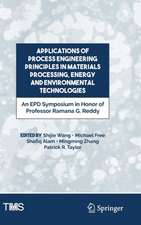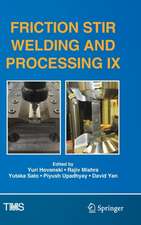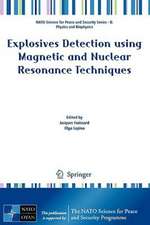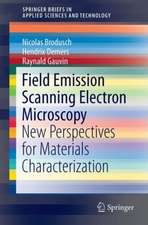Computational Quantum Mechanics for Materials Engineers: The EMTO Method and Applications: Engineering Materials and Processes
Autor Levente Vitosen Limba Engleză Paperback – 22 oct 2010
| Toate formatele și edițiile | Preț | Express |
|---|---|---|
| Paperback (1) | 937.05 lei 6-8 săpt. | |
| SPRINGER LONDON – 22 oct 2010 | 937.05 lei 6-8 săpt. | |
| Hardback (1) | 943.83 lei 6-8 săpt. | |
| SPRINGER LONDON – 13 aug 2007 | 943.83 lei 6-8 săpt. |
Din seria Engineering Materials and Processes
-
 Preț: 397.54 lei
Preț: 397.54 lei - 18%
 Preț: 1237.93 lei
Preț: 1237.93 lei - 18%
 Preț: 950.52 lei
Preț: 950.52 lei - 15%
 Preț: 646.30 lei
Preț: 646.30 lei - 18%
 Preț: 1383.00 lei
Preț: 1383.00 lei - 18%
 Preț: 1826.07 lei
Preț: 1826.07 lei - 5%
 Preț: 676.35 lei
Preț: 676.35 lei - 18%
 Preț: 1237.80 lei
Preț: 1237.80 lei - 18%
 Preț: 1228.62 lei
Preț: 1228.62 lei - 15%
 Preț: 644.95 lei
Preț: 644.95 lei - 15%
 Preț: 636.63 lei
Preț: 636.63 lei - 18%
 Preț: 1217.41 lei
Preț: 1217.41 lei - 20%
 Preț: 337.00 lei
Preț: 337.00 lei - 20%
 Preț: 557.21 lei
Preț: 557.21 lei - 15%
 Preț: 644.18 lei
Preț: 644.18 lei - 18%
 Preț: 956.50 lei
Preț: 956.50 lei - 18%
 Preț: 781.31 lei
Preț: 781.31 lei - 15%
 Preț: 640.06 lei
Preț: 640.06 lei - 23%
 Preț: 691.73 lei
Preț: 691.73 lei - 18%
 Preț: 941.50 lei
Preț: 941.50 lei - 18%
 Preț: 945.30 lei
Preț: 945.30 lei - 18%
 Preț: 952.09 lei
Preț: 952.09 lei - 15%
 Preț: 635.31 lei
Preț: 635.31 lei - 18%
 Preț: 1383.81 lei
Preț: 1383.81 lei - 15%
 Preț: 644.95 lei
Preț: 644.95 lei - 18%
 Preț: 1222.45 lei
Preț: 1222.45 lei - 18%
 Preț: 1322.04 lei
Preț: 1322.04 lei - 18%
 Preț: 945.30 lei
Preț: 945.30 lei - 15%
 Preț: 640.02 lei
Preț: 640.02 lei - 18%
 Preț: 1545.72 lei
Preț: 1545.72 lei - 24%
 Preț: 848.85 lei
Preț: 848.85 lei - 18%
 Preț: 1115.14 lei
Preț: 1115.14 lei - 15%
 Preț: 632.55 lei
Preț: 632.55 lei - 18%
 Preț: 948.79 lei
Preț: 948.79 lei
Preț: 937.05 lei
Preț vechi: 1142.75 lei
-18% Nou
Puncte Express: 1406
Preț estimativ în valută:
179.31€ • 191.74$ • 149.50£
179.31€ • 191.74$ • 149.50£
Carte tipărită la comandă
Livrare economică 18 aprilie-02 mai
Preluare comenzi: 021 569.72.76
Specificații
ISBN-13: 9781849966856
ISBN-10: 1849966850
Pagini: 252
Ilustrații: XII, 237 p. 92 illus.
Dimensiuni: 155 x 235 x 13 mm
Greutate: 0.36 kg
Ediția:Softcover reprint of hardcover 1st ed. 2007
Editura: SPRINGER LONDON
Colecția Springer
Seria Engineering Materials and Processes
Locul publicării:London, United Kingdom
ISBN-10: 1849966850
Pagini: 252
Ilustrații: XII, 237 p. 92 illus.
Dimensiuni: 155 x 235 x 13 mm
Greutate: 0.36 kg
Ediția:Softcover reprint of hardcover 1st ed. 2007
Editura: SPRINGER LONDON
Colecția Springer
Seria Engineering Materials and Processes
Locul publicării:London, United Kingdom
Public țintă
ResearchCuprins
The Method.- Basics of Electronic Structure Calculations.- Exact Muffin-tin Orbitals Method.- Slope Matrix.- Full Charge Density Technique.- The EMTO-CPA Method.- Applications.- Ground-state Properties.- Ordered Solids.- Binary Alloys.- Iron—chromium—nickel Alloys.
Notă biografică
Dr Levente Vitos is a research fellow at the Research Institute for Solid State Physics and Optics (SZFKI), Budapest, a guest professor at KTH, Sweden, and a researcher at Uppsala University, Sweden. Dr Vitos is considered a world expert on the application of the LMTO quantum mechanical method and its application in materials systems, and the he is the creator of the new EMTO-CPA method. These methods represent the first useful applications of modern applied quantum mechanics that can be used practically in the industrial world of metallurgy and alloy design to model and create novel materials.
Textul de pe ultima copertă
Traditionally, new materials have been developed by empirically correlating their chemical composition, and the manufacturing processes used to form them, with their properties. Until recently, metallurgists have not used quantum theory for practical purposes. However, the development of modern density functional methods means that today, computational quantum mechanics can help engineers to identify and develop novel materials.
Computational Quantum Mechanics for Materials Engineers describes new approaches to the modelling of disordered alloys that combine the most efficient quantum-level theories of random alloys with the most sophisticated numerical techniques to establish a theoretical insight into the electronic structure of complex materials such as stainless steels, Hume-Rothery alloys and silicates. The practical success of these approaches to applications in all of these areas are covered in detail. The new EMTO-CPA method is detailed, including its application in alloys to model structural stability and elastic properties of random alloys of arbitrary composition and the effect of alloying elements on elastic stiffnesses stacking fault energies and structural parameters. The EMTO-CPA method makes new approaches to computational alloy design feasible. Computational Quantum Mechanics for Materials Engineers shows how the technique will soon allow materials engineers to become "quantum blacksmiths".
Computational Quantum Mechanics for Materials Engineers will interest researchers and postgraduate students in materials science and engineering, solid-state physics and applied quantum mechanics.
Computational Quantum Mechanics for Materials Engineers describes new approaches to the modelling of disordered alloys that combine the most efficient quantum-level theories of random alloys with the most sophisticated numerical techniques to establish a theoretical insight into the electronic structure of complex materials such as stainless steels, Hume-Rothery alloys and silicates. The practical success of these approaches to applications in all of these areas are covered in detail. The new EMTO-CPA method is detailed, including its application in alloys to model structural stability and elastic properties of random alloys of arbitrary composition and the effect of alloying elements on elastic stiffnesses stacking fault energies and structural parameters. The EMTO-CPA method makes new approaches to computational alloy design feasible. Computational Quantum Mechanics for Materials Engineers shows how the technique will soon allow materials engineers to become "quantum blacksmiths".
Computational Quantum Mechanics for Materials Engineers will interest researchers and postgraduate students in materials science and engineering, solid-state physics and applied quantum mechanics.
Caracteristici
Only book to cover the most recent developments in applied quantum theory and their use in modelling materials properties First book to cover the applications of these techniques in materials engineering Includes supplementary material: sn.pub/extras














